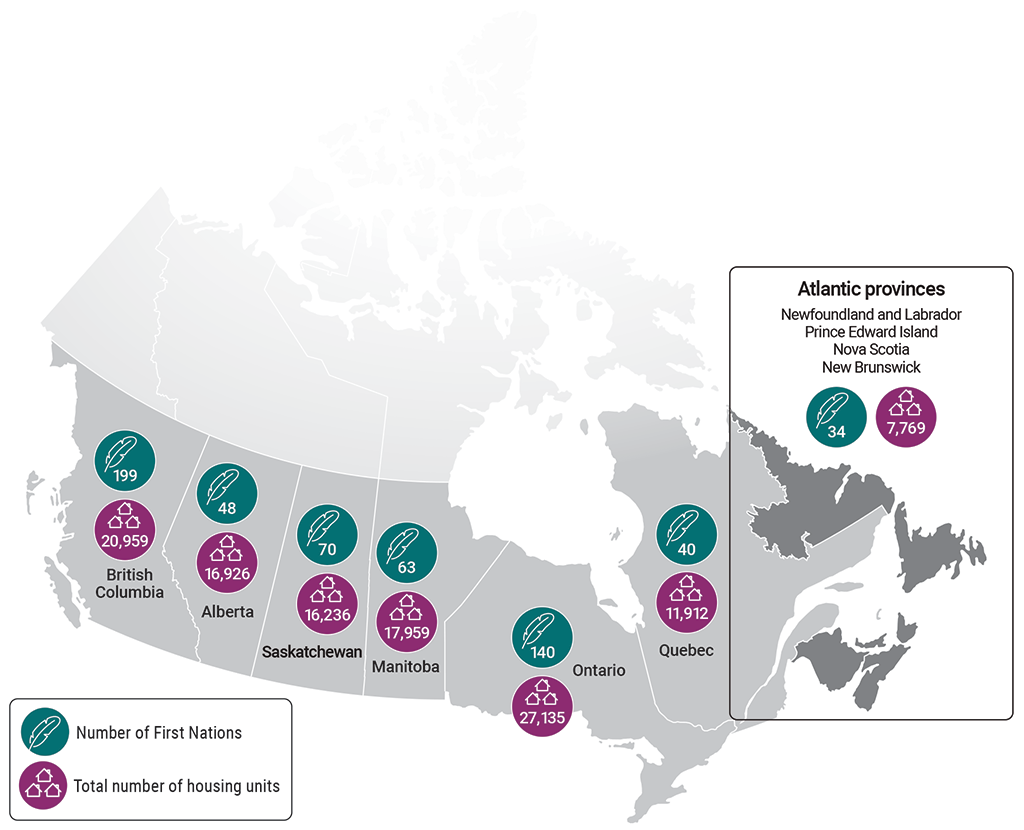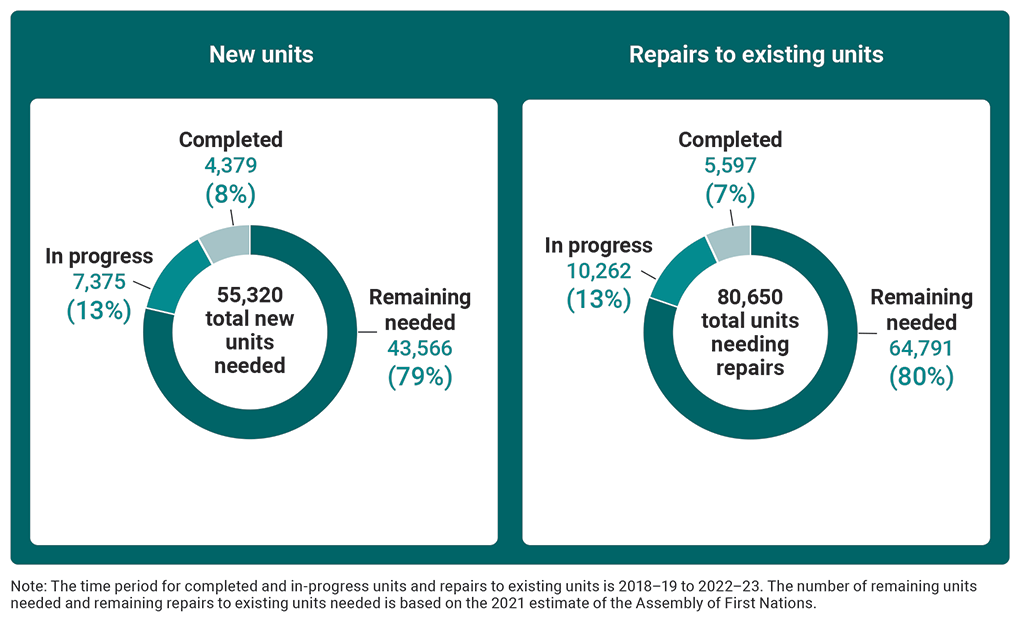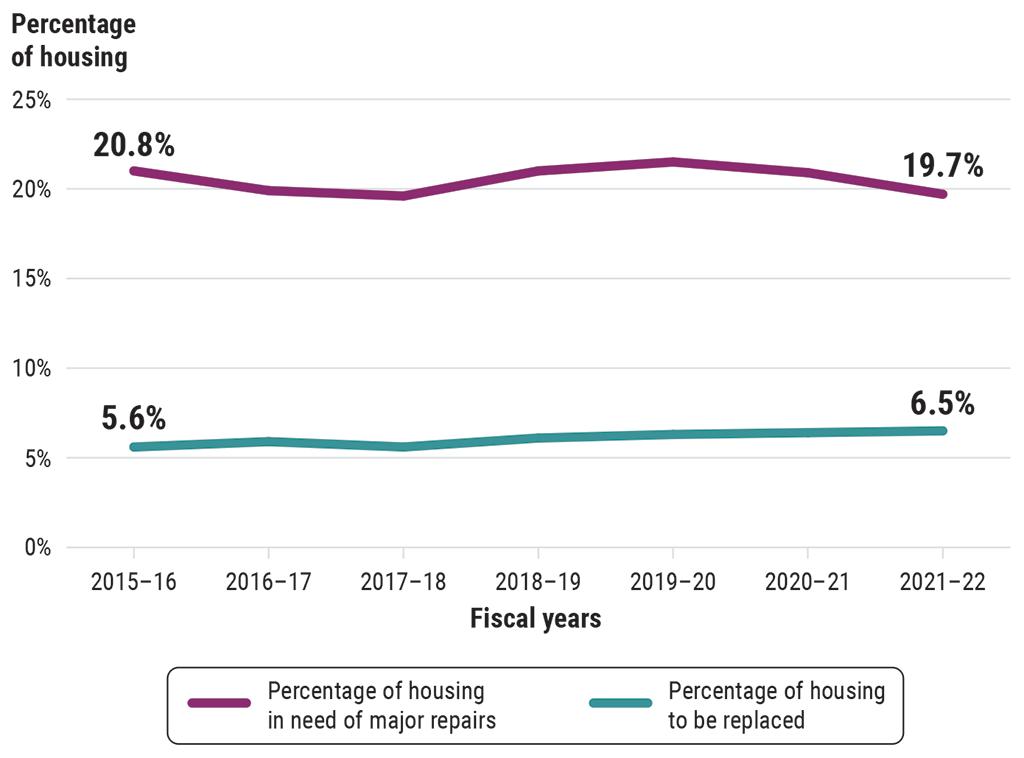2024 Reports 2 to 4 of the Auditor General of Canada to the Parliament of Canada
Report 2—Housing in First Nations Communities
At a Glance
Many people living in First Nations communities do not have access to housing that is safe and in good condition—a fundamental human right. Improving housing for First Nations is vital for their physical, mental, and economic health and well‑being.
This is the fourth time since 2003 that we have raised concerns about housing in First Nations communities, and—20 years later—many of these concerns persist. Despite these audits, we found that Indigenous Services Canada and the Canada Mortgage and Housing Corporation have made little progress in supporting First Nations to improve housing conditions in their communities.
Indigenous Services Canada and the Canada Mortgage and Housing Corporation have been mandated to work with First Nations to meet their housing needs by 2030. We found that 80% of these needs were still not met with 7 years left before 2030.
Neither the department nor the corporation prioritized their limited funding for communities with the greatest housing needs. For example, we found that, overall, First Nations communities with the poorest housing conditions received less funding than communities of the same size with better housing conditions.
Mould in First Nations homes is a long‑standing health hazard, and Indigenous Services Canada and the Canada Mortgage and Housing Corporation still had not identified the magnitude of the problem. Neither the department nor the corporation had assurance that the quality of all the homes they funded met building code standards. Poor quality housing is a key contributor to mould growth.
As part of the broader reconciliation process, Indigenous Services Canada has a legislated mandate to transfer its responsibilities, including housing, to First Nations. We found that Indigenous Services Canada was at the early stages of transferring control of housing to First Nations, but no overarching policy framework was in place to guide the department’s work in transferring its programs to First Nations communities.
Key facts and findings
- There are about 600 First Nations communities in the provinces. Indigenous Services Canada data from the 2021–22 fiscal year indicated that about 119,000 housing units are located in these First Nations communities.
- People in First Nations communities are 4 times more likely to live in crowded housing and 6 times more likely to live in housing in need of major repairs than non‑Indigenous people, according to Canada’s 2021 Census.
- To close the housing gap, First Nations communities need 55,320 new housing units and repairs to 80,650 existing units, at an estimated cost of $44 billion, according to a 2021 report by the Assembly of First Nations.
- Over the last 5 fiscal years, Indigenous Services Canada and the Canada Mortgage and Housing Corporation spent $3.86 billion on improving housing in First Nations communities. This funding supported building new homes, repairing existing homes, and increasing First Nations’ capacity to manage housing.
- From 2018–19 to 2022–23, Indigenous Services Canada and the Canada Mortgage and Housing Corporation provided funding to build 11,754 new housing units and repair 15,859 existing units in First Nations communities. This represents 21% of the new housing units and 20% of the repairs to existing units needed to close the gap.
- There was no meaningful improvement in housing conditions in First Nations communities. From 2015–16 to 2021–22, the percentage of homes in need of major repairs decreased from 20.8% to 19.7%, while the percentage of homes in First Nations communities that needed to be replaced increased from 5.6% to 6.5%.
Why we did this audit
- Improving housing in First Nations communities is vital to the physical, mental, and economic health and well-being of the people living there.
- Improving housing and transferring the control of housing to First Nations play important roles in advancing self‑determination and reconciliation.
- Indigenous Services Canada and the Canada Mortgage Housing Corporation are responsible for providing support to First Nations through their housing programs. If these programs do not provide the supports needed, people in First Nations communities will continue to experience poor and unsafe housing.
- First Nations’ control over the design and delivery of housing is essential for high‑quality, culturally relevant services, ultimately leading to better socio-economic outcomes for First Nations individuals, families, and communities.
Highlights of our recommendations
- Indigenous Services Canada and the Canada Mortgage and Housing Corporation, in collaboration with First Nations, should develop and implement a strategy to close the housing gap by 2030 that outlines how they will coordinate their efforts, identifies needs and required funding, and establishes measurable targets for tracking progress.
- Indigenous Services Canada and the Canada Mortgage and Housing Corporation should work with First Nations to better understand the extent of mould in housing in First Nations communities and use this information to support First Nations in reducing mould in housing.
- Indigenous Services Canada and the Canada Mortgage and Housing Corporation should work with the First Nations communities with the poorest housing conditions to ensure that they receive the support they need to improve housing conditions.
- Indigenous Services Canada, in collaboration with First Nations, should finalize the overarching policy framework for the transfer of departmental responsibilities to First Nations to ensure that a consistent approach is applied to the transfer of housing.
Please see the full report to read our complete findings, analysis, recommendations and the audited organizations’ responses.
Exhibit highlights
The number of First Nations and the number of housing units on reserve in the provinces, as of 31 March 2022

Source: Based on data from Community Infrastructure and Housing Annual Report, Indigenous Services Canada, 2021–22; and First Nation Profiles, Crown‑Indigenous Relations and Northern Affairs Canada and Indigenous Services Canada
Text version
This map shows the number of First Nations and the number of housing units on reserve in the provinces, as of 31 March 2022.
British Columbia had 199 First Nations and 20,959 housing units on reserve.
Alberta had 48 First Nations and 16,926 housing units on reserve.
Saskatchewan had 70 First Nations and 16,236 housing units on reserve.
Manitoba had 63 First Nations and 17,959 housing units on reserve.
Ontario had 140 First Nations and 27,135 housing units on reserve.
Quebec had 40 First Nations and 11,912 housing units on reserve.
The Atlantic provinces—that is, Newfoundland and Labrador, Prince Edward Island, Nova Scotia, and New Brunswick—had 34 First Nations and 7,769 housing units on reserve combined.
Indigenous Services Canada and the Canada Mortgage and Housing Corporation were not on track to close the housing gap by 2030

Source: Based on data from Indigenous Services Canada, from the Canada Mortgage and Housing Corporation, and from the Final Report: Cost Analysis of Current Housing Gaps and Future Housing Needs in First Nations, Assembly of First Nations, 2021
Text version
These charts show the total number of new housing units needed and existing housing units needing repairs to close the housing gap by 2030.
Of the 55,320 total new units needed, there were 43,566 remaining units needed (79%); 7,375 units that were in progress (13%); and 4,379 units that were completed (8%).
Of the 80,650 total existing units needing repairs, there were 64,791 remaining units that needed repairs (80%); 10,262 units whose repairs were in progress (13%); and 5,597 units whose repairs were completed (7%).
Note: The time period for completed and in-progress units and repairs to existing units is 2018–19 to 2022–23. The number of remaining new units needed and remaining existing units needing repairs is based on the 2021 estimate of the Assembly of First Nations.
There was no meaningful improvement in First Nations housing conditions from 2015–16 to 2021–22

Source: Based on data from Community Infrastructure and Housing annual reports, Indigenous Services Canada, from 2015–16 to 2021–22
Text version
This graph shows the percentage of housing in need of major repairs and needing to be replaced from the 2015–16 to 2021–22 fiscal years.
The data showed no meaningful improvement in First Nations housing conditions during this period. The percentage of homes in need of major repairs decreased slightly from 20.8% to 19.7%, while the percentage of homes in First Nations communities that needed to be replaced increased slightly from 5.6% to 6.5%.
Small communities with the poorest housing conditions were approved for less targeted funding from 2018–19 to 2022–23 than small communities with better housing conditions
| Housing units in need of major repairs or replacement | Number of small communities with fewer than 100 housing units | Average approved targeted funding per small community |
|---|---|---|
| Less than 75% | 191 | $2.56 million |
| 75% or moreNote * | 19 | $1.99 million |
Source: Based on data from Indigenous Services Canada and the Canada Mortgage and Housing Corporation
Infographic

Text version
Housing in First Nations Communities
Indigenous Services Canada and the Canada Mortgage and Housing Corporation have made little progress in improving housing conditions in First Nations communities. This is our fourth audit since 2003, and many of the same issues persist.
There are 600 First Nations communities in Canada’s provinces, and there are 119,000 housing units in these communities.
People in First Nations communities are 4 times more likely to live in crowded housing and 6 times more likely to live in housing in need of major repairs than the non‑Indigenous population.
It is unlikely that Indigenous Services Canada and the Canada Mortgage and Housing Corporation will close the gap by 2030
Of the 55,000 new units needed,12,000 are under construction or are built.
Of the 81,000 existing units needing repairs,16,000 are being repaired or are completed.
No meaningful improvement in First Nations housing conditions since the 2015–16 fiscal year
A graph shows the percentage of housing in need of major repairs and needing to be replaced from the 2015–16 to 2021–22 fiscal years. The percentage of homes in need of major repairs decreased slightly from 20.8% to 19.7%, while the percentage of homes in First Nations communities that needed to be replaced increased slightly from 5.6% to 6.5%.
Source: Based on data from Community Infrastructure and Housing annual reports, Indigenous Services Canada, from 2015–16 to 2021–22
Mould is a long‑standing problem, but Indigenous Services Canada and the Canada Mortgage and Housing Corporation do not know how bad it is
Only one of Indigenous Services Canada's regional offices collected information about mould.
According to that regional office in Alberta, one third of communities in Alberta reported that 30% or more of homes had mould.
The 2008 mould strategy was no longer being used, and no reason why was given.
Improving housing for First Nations is vital for their physical, mental, and economic health and well‑being.
Related information
Tabling date
- 19 March 2024
Related audits
- 2024 Reports of the Auditor General of Canada to the Parliament of Canada
Report 3—First Nations and Inuit Policing Program - 2021 Reports of the Auditor General of Canada to the Parliament of Canada
Report 3—Access to Safe Drinking Water in First Nations Communities—Indigenous Services Canada - 2018 Spring Reports of the Auditor General of Canada to the Parliament of Canada
Report 5—Socio-economic Gaps on First Nations Reserves—Indigenous Services Canada - 2011 Reports of the Auditor General of Canada to the Parliament of Canada
Chapter 4—Programs for First Nations on Reserves - 2006 Reports of the Auditor General of Canada to the Parliament of Canada
Chapter 5—Management of Programs for First Nations - 2003 Reports of the Auditor General of Canada to the Parliament of Canada
Chapter 6—Federal Government Support to First Nations—Housing on Reserves
